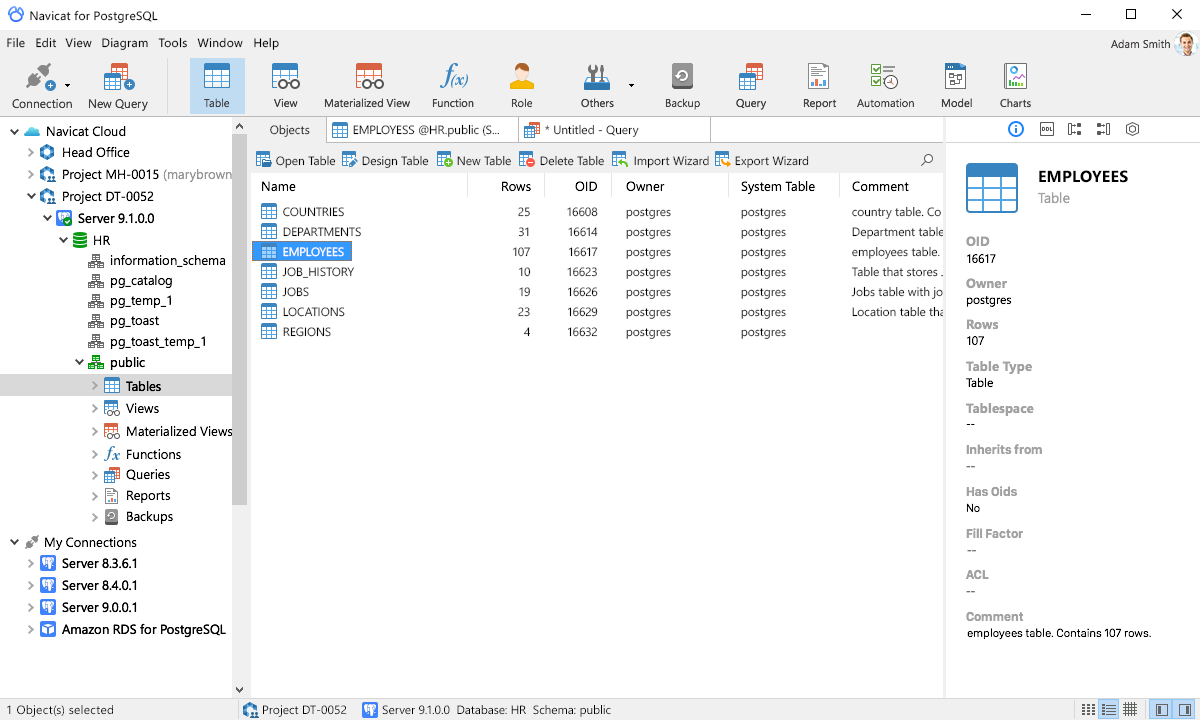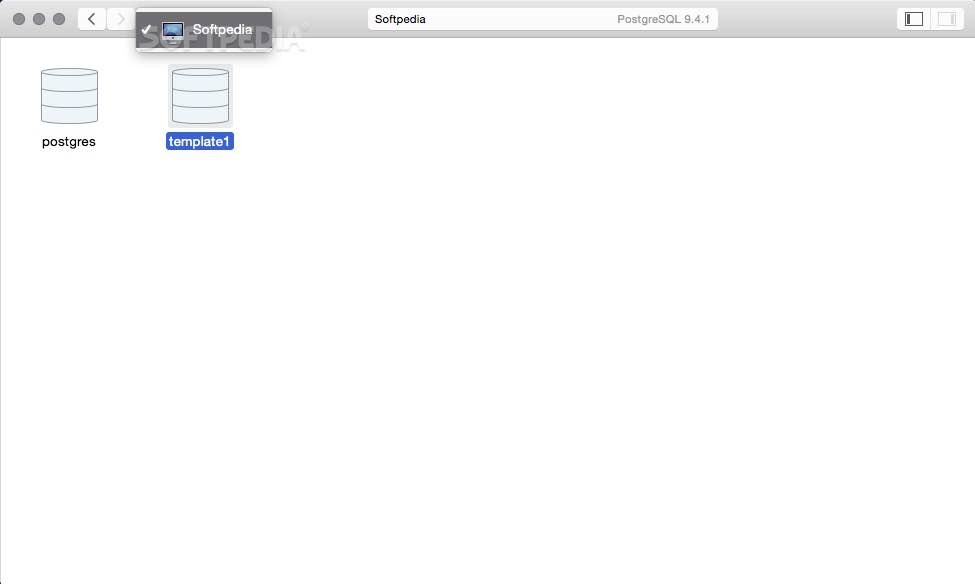Postico requires macOS 10.10 or later. Version 1.5.14 was released on Jul 17, 2020. Read the Changelist.
Also available on the Mac App Store. We also offer Legacy Downloads for older versions of macOS.
Postico is under active development. Leave your email adress and I'll tell you about new features as soon as they're ready.
Valentina Studio is free and available on the Mac OS X platform. I can't help but notice many answers here are for products that don't have a free version. Valentina Studio is easy to use, and is regularly updated on a regular basis. PgAdmin 4 is a feature rich open source PostgreSQL client. It has support for almost every feature in PostgreSQL. The only downside is that the cross-plattform UI really doesn’t live up to the expectations of a native Mac app. Postico on the other hand, is a very modern Mac app. It’s made by the same people that maintain Postgres.app,. It is free and open-source GUI client and available for Ubuntu including Windows and Mac OS X. PgAdmin is a feature-rich PostgreSQL client which supports multiple PostgreSQL versions, color syntax highlighting, procedural language debugger, create, view and edit all most widely used PostgreSQL objects such as database, columns, triggers. SEQUEL for PostgreSQL is a professional DB administration and management tool, with extremely intuitive and feature rich GUI that makes it the best assistant tool for developers and admins. SEQUEL is lightweight, fast and powerful that it can significantly simplify the DB management process. For those who cannot live without a CLI, SEQUEL offers a powerful Query Editor with syntax highlight.
PostgreSQL is an absurdly powerful database, but there's no reason why using it should require an advanced degree in relational theory. Postico provides an easy to use interface, making Postgres more accessible for newcomers and specialists alike.
Postico will look familiar to anyone who has used a Mac before. Just connect to a database and begin working with tables and views. Start with the basics and learn about advanced features of PostgreSQL as you go along.
Postico is an intuitive app for looking at data. Filter rows, sort them, rearrange columns. You can examine long text or images conveniently in the sidebar. Even related rows from referenced tables are shown.
Postgresql Client For Mac

Edit rows directly, or use the sidebar — a great choice for long text. You can even change multiple rows at once. Batch saving (with SQL preview) lets you commit changes to multiple rows in a single transaction.

Add and remove columns, rename them, change types. Modify tables and views without having to remember the ALTER TABLE syntax.
The unified structure editor displays everything you need to know about a table. Comments and constraints are shown right next to the columns.
When you need hard questions answered, PostgreSQL offers many advanced tools for data analysis: Common table expressions, recursive queries, filter aggregates, window functions.
To access these tools, Postico sports a powerful query view with support for multiple result sets. The editor has all the standard features you expect, like syntax highlighting and automatic indentation.
Native Experience
Native Cocoa controls ensure consistency. Keyboard shortcuts follow platform conventions. Commands like undo/redo or copy/paste work just as you'd expect. And of course, Postico plays nice with other apps and services you use every day.
Vibrant Design
Postico was designed from the ground up with Apple's modern design language in mind. Its high resolution artwork looks great on Retina displays.
Postgresql Download For Mac
Secure out of the box
Postico uses industry standard encryption: both SSL and SSH can be used for secure connections. Server certificates are always validated. Passwords are stored safely in the system keychain. A warning is shown if the server requests a plain text connection.
Dependable Customer Support
When you have a question, you can contact the developers directly — We personally answer all customer emails. You don't have to deal with outsourced support agents, and you'll never get a canned response.

A Companion to Postgres.app
Postgres.app is the fastest way to run a PostgreSQL server locally. Since Postico is made by the maintainer of Postgres.app, the two apps co-operate perfectly.
Optimized for small displays
A slim toolbar conserves vertical screen estate. The sidebars can be hidden to show more of your data. And if you don't want to waste a single pixel, switch to full screen mode.
- Announcements of major new features
- Notification when security issues come up
- 3-4 emails per year
Which versions of PostgreSQL are supported?
Postico supports PostgreSQL 8.0 and later. We run automated tests to ensure compatibility with PostgreSQL 8.4, 9.x, 10, 11, and 12. Postico also supports database systems derived from PostgreSQL like Amazon Redshift or Greenplum, and systems that use the PostgreSQL protocol like CockroachDB.
What are the limitations of the free trial?
- At most 5 connection favorites
- Only a single window per connection
- Table filters are disabled
- There is no time limit — use the trial as long as you want!
Should I buy Postico on the Mac App Store or from your website?
It's your choice! Many customers prefer the convenience of the App Store. You have all licenses in one place, and your software is automatically updated. The store on my website (operated by Fastspring) has better support for business customers. Also, Fastspring charges a lower commission, so the version on my website is slightly cheaper.
I work for a software reseller. Who should I contact to get quotes?
Please see this document with information for resellers.
Do you have an issue tracker for bug reports and feature requests?
I've set up a Github repository for public feature requests and bug reports. But of course you can also reach out privately via email: postico@eggerapps.at.
If you need a bug fixed quickly, consider following the best practices for bug reporting.

This is a tutorial for setting up PostgreSQL on MacOS. You might be wondering why there's a need for another setup guide for Postgres in the first place, since there are a few across the web. I found many tutorials and guides on how to set it up, but found most of them to be unclear and outdated, based on old PostgreSQL versions. The checklist is not comprehensive, though, as it is used for several tutorials on my website, I keep it updated with the recent versions of PostgreSQL. If you spot any flaws in this guide, a comment below would be very helpful to keep it up to date for other developers.
If you want to run PostgreSQL on Windows instead, you will find guidance over here: How to setup PostgreSQL on Windows.
PostgreSQL Installation on MacOS
I recommend Homebrew for installing and managing applications on MacOS. It is installed using the following command in the MacOS terminal:

The terminal runs through a series of installation operations, and will probably create folders in your local machine to accommodate Homebrews storage requirements. You can find more detailed instructions here. After it's installed, update the Homebrew dependencies and install PostgreSQL on the command line:
Next, check your PostgreSQL version:
The command line results will show the version you have installed on your local machine. I recommed using the latest version of libraries and software whenever possible to avoid compatibility issues with client-side applications.
How to create a physical PostgreSQL Database
Now you can initialize the physical space on your hard-disk to allocate databases. To do this, create a default postgres database on the command line in case it didn't happen automatically:
You will see the error message: 'initdb: directory '/usr/local/var/postgres' exists but is not empty' if the database was already created when you installed PostgreSQL. It means the folder where you are attempting to create a physical place for the database already has one. Either way, next you can move on to the next step.
When you connect to this physical database later, you will see an actual database which is called 'postgres' as well. The postgres database is meant to be the default database for any third-party tools that you are using in combination with PostgreSQL. These tools attempt to make the default connection to this default database, so you shouldn't delete it.
How to start/stop a PostgreSQL Database
Let's see next how you can interact with the actual database. Manually start and stop your Postgres database server with the following commands:
The terminal will confirm these operations with 'server started' and 'server stopped' feedback. You could also implement a script to start the server each time you boot up the machine, but I like to have control over when to start and stop my database server to avoid complications.
How to create the actual PostgreSQL Database
Next, let's go through the steps of setting up a database that can be used for one of your applications. Make sure the Postgre server is started first, then type these commands in the command line to create and remove a database:
You can also connect to databases to execute SQL statements. Either use the psql command, or specify a database such as the default postgres database to connect:
The command leads you to the psql shell, which you can exit by typing CTRL + d. In the psql shell, you can create and drop databases as well:
To list all your databases, you can type list. Your will see any new databases listed, as well as two default databases that come with postgreSQL called template0 and template1. The templates should remain in your database list even if you aren't using them, as they may be useful later.
- list - List all of your actual databases.
- c mydatabasename - Connect to another database.
- d - List the relations of your currently connected database.
- d mytablename - Shows information for a specific table.
